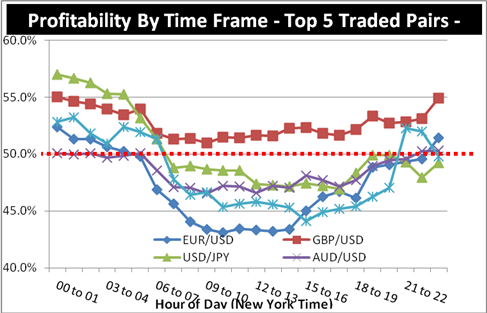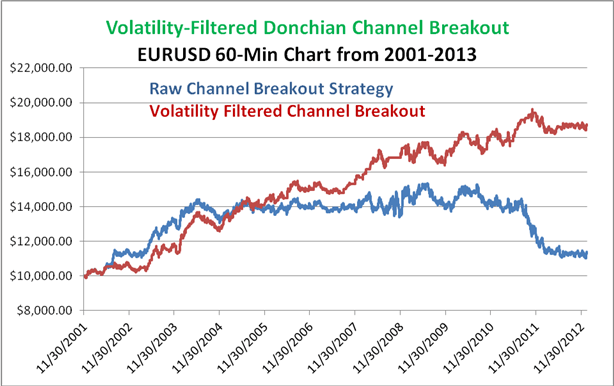Our research on forex seasonality showed that most traders could be well-served restricting their trading to less-active trading hours, but what if you can’t trade when it’s quiet? For traders who feel the need to be in the market during the more volatile times, here is some advice about how to do it.

Our previous report on trading during certain hours of the day emphasized that most traders do poorly during active markets. We looked through 12 million real trades conducted by retail traders, and the data we found was quite revealing.
The chart above shows that average profitability varies significantly throughout different trading session. The takeaway was fairly straightforward: for most traders, avoiding the most active trading sessions can improve performance.
In our hypothetical results, the returns of a simple Relative Strength Index (RSI) trading strategy improved dramatically when we limited its trading to the hours of 2:00 PM – 6:00 AM Eastern Time.
But limiting trading to those hours is impractical for some and unsatisfying for others—there should be a way to take advantage of stronger volatility. And that’s exactly where we come upon breakout trading strategies.
What Strategy Can We Use to Trade the US Daytime?
We believe most should avoid trading during volatile hours due to clear patterns in real trader performance, but we also acknowledge that this may be impractical or undesirable for many. The reason is simple: most retail traders use range trading strategies, which do poorly in volatile trading conditions. If trading during active hours, we believe breakout strategies are more likely to succeed.
What is a Breakout?
A breakout is when a currency that has been trapped in a range breaks through support or resistance, escaping the range. When this happens, the movement in prices can be very powerful and can create a trading opportunity.
Here is an example where the US Dollar/Japanese Yen Daily chart held a narrow price channel for over 12 months. You can see that when this channel broke, the move was swift and powerful.
US Dollar/Japanese Yen Daily Chart Shows Major Breakout

Prepared by David Rodriguez
How Can We Trade Breakouts?
Trading breakouts is almost the exact opposite of range trading. Most traders instinctively buy a currency pair when it has fallen and is near support and sell when price is expensive and near resistance. They do this in anticipation that price will reverse and stick to broad trading ranges—or range trade, for short.
Breakout trading strategies buy the currency pair when it rallies above resistance and sell it when it breaks below support. These breakout trades work when price continues significantly higher or lower, and they perform poorly when currencies stick to well-defined trading ranges. In other words, breakout trading will often work when range trading does not. Let’s use this to our advantage.
Sample Strategy: Donchian Channel Breakout
The Donchian Channel Breakout strategy is straightforward. The system draws a channel surrounding price action, with the top of the channel set at the highest high and the bottom set at the lowest low of the past 20 bars.
In the chart below, you can see the top and bottom of the channel in blue. The blue vertical lines show breaks above and below the Donchian channel. The dashed line shows profitable trades made by the system, while the red dashed line shows losing trades made by the system.
Donchian Channel Breakout Strategy on a USDJPY 60-Minute Chart

Prepared by David Rodriguez
The strategy sells the currency pair if the price breaks below the channel bottom. If price quickly reverses, it will be taken out of the trade at a loss. Yet if price continues lower, the strategy stands to see profits on the continued moves. It likewise buys the currency pair if price breaks above the channel top.
Thus we can conceptualize that this trade system might work especially well during times of high volatility, when channels tend to be broken. Let’s test by looking at how well it has done on the Euro/US Dollar in the past several years:
Channel Breakout Strategy on EURUSD Pair from 2001-2013, 60min Chart

The channel breakout system did reasonably well overall, and especially well during times of strong market volatility in late 2009. Yet it has also had long stretches of underperformance and noteworthy losing streaks. Since we know that breakout strategies tend to work better during times of higher volatility, how can we instruct our system to trade only during those times?
When Can We Look to Trade Breakouts?
We publish Volatility Percentile figures on the DailyFX Technical Analysis page for reference. The Volatility Percentile is derived from FX options prices.
The higher the number, the more volatile options traders expect the currency pair to be. We can use these volatility percentages to judge when it may be best to use particular strategies. When volatility percentiles are high, we look to trade breakout strategies. When they are low, we look to avoid them.
When looking at the Channel Breakout strategy above, our research shows that the strategy hypothetically improved noticeably when we apply filters. We plot two hypothetical results below.
In one case, the strategy is allowed to trade whenever the EURUSD breaks above its 20-hour high or below its 20-hour low. In the other, it is only allowed to take those trades when the EURUSD Volatility Percentile is above 75%. As you can see in the chart below, the volatility-filtered result is hypothetically an important improvement over the base strategy.
Volatility-Filtered Breakout Strategy on EURUSD Pair from 2001-2013, 60min Chart

With the 75 percentile filter, the system can only trade roughly 25 percent of the time. Obviously this means that we’re rarely trading—likely frustrating at points—but we feel that the hypothetical improvement in the strategy’s returns could justify the trade filter.
Game Plan: What Strategy Can We Use?
When volatility is above 75%, we may use a Channel Breakout trading strategy. Our data show that over the past 10 years many individual currency traders have generally been unsuccessful trading in times of high volatility. As we spoke about in our earlier article on real trader successes and failures, we generally recommend trading European currencies during the “Off Hours” using a range trading strategy. Such an approach has historically produced good results and best matches how most retail traders trade.
We believe that traders who feel the need to trade during times of high volatility should use a different strategy and look to trade breakouts rather than ranges. Breakout trading has historically shown superior risk-adjusted returns if limited to the most volatile trading days.
We can use the DailyFX Volatility Percentage to gauge what FX options traders expect for volatility in the near future. When above 75%, breakouts are historically more likely than normal, so look for opportunities.
Model Strategy: Donchian Channel Breakout Trading on a 60 Minute Chart
For our models, we used one of the most common and simple breakout trading strategies there is, creating channels on a 60 minute chart.
Entry Rule: When price crosses above the highest price of the last 20 bars, buy at market on the open of the next bar. When price crosses below the lowest price of the last 20 bars, sell at market on the open of the next bar.
Filter: Strategy can only enter new trades when the Volatility Percentage is above the specified level (such as the 50% or 75% examples used above).
Exit Rule: Strategy will exit a trade and flip direction when the opposite signal is triggered.
As was shown earlier, in the EUR/USD this strategy has shown the best risk-adjusted returns in the EUR/USD over the past 6 years when it was restricted to trade only when the Volatility Percentage was above 75%.
________________________________________________________
The Traits of Successful Traders
This article is a part of our Traits of Successful Traders series. View the previous installment of this series:
Why do Many Forex Traders Lose Money?
What Time of Day Should I Trade?
The DailyFX Research team has been closely studying the trading trends of retail traders. We have gone through an enormous number of statistics and anonymized trading records in order to answer one question: “What separates successful traders from unsuccessful traders?”. We have been using this unique resource to distill some of the “best practices” that successful traders follow, such as the best time of day, appropriate use of leverage, the best currency pairs, and more.
Written by David Rodriguez, Quantitative Strategist for DailyFX.com
Contact David via
Twitter at http://www.twitter.com/DRodriguezFX
Facebook at http://www.Facebook.com/DRodriguezFX




